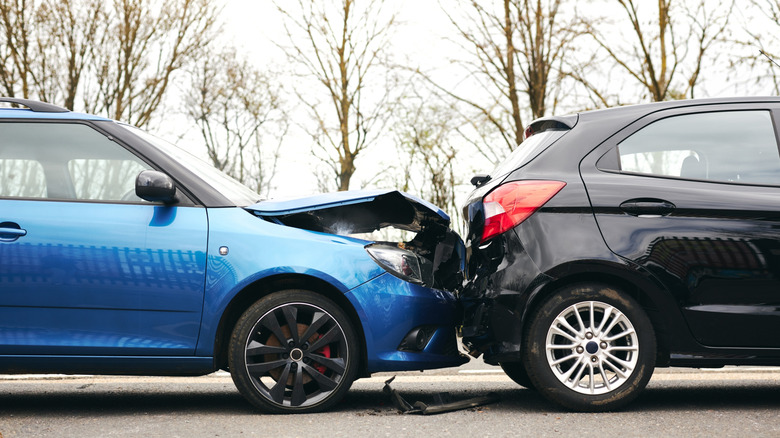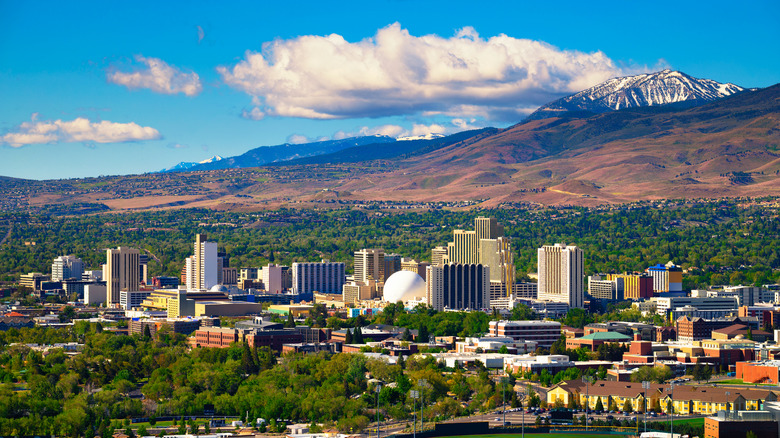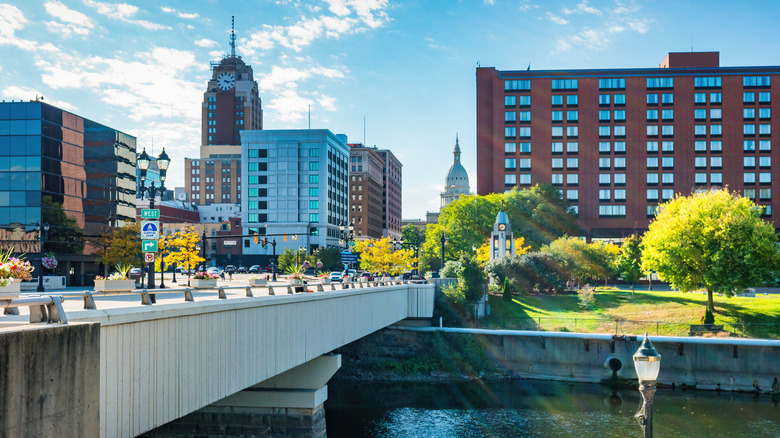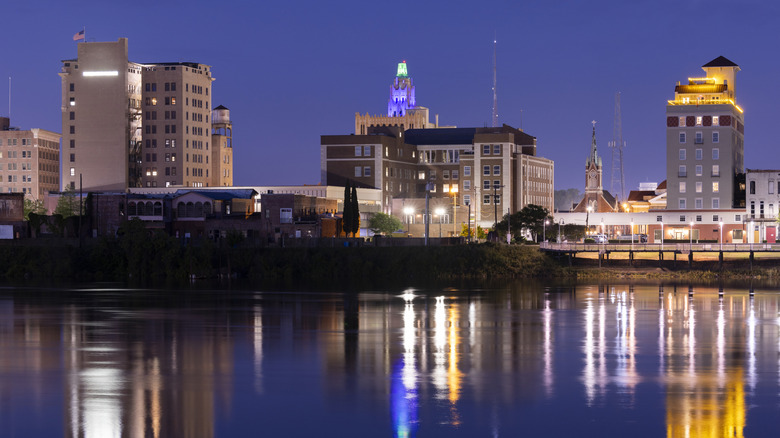Ranked: US States With The Highest Car Insurance Rates
Owning a car comes with the understanding that you've invested in a consistent money drain. It's necessary to get from point A to B, especially if you don't live in a particularly walkable city with proper public transportation, but that won't necessarily take the sting out of your wallet. Besides actually purchasing the car, you'll need to maintain and pay insurance premiums to significantly reduce the possibility of hefty expenses sneaking up on you.
A million and one things could go wrong during your car ownership; accidents, thefts, and even natural disasters can burn a hole in your pocket without coverage. It's why car insurance is required by law in virtually every state in the U.S. (except for New Hampshire). The exact minimum payable amount varies from state to state due to a bevy of factors: frequency of lawsuits, number of claims, and whether you're in a "no-fault" state. If you're looking for how to save a few bucks, SlashGear has covered your options to get cheaper car insurance.
However, for the purposes of this article, we'll not be dealing with minimums. Instead, we'll look at the more realistic annual cost of full coverage. The average driver in America spends $2,149 on insurance premiums for full coverage in a year per Forbes – again, this figure depends on factors such as age, credit score, vehicle type, and location. Location is our primary concern, so here are the five states in the U.S. with the highest car insurance rates.
Nevada ($3,010)
Car insurance rates rose sharply over the last two years in the United States, and Nevada was one of those hardest hit by the insurance premium hikes. Rates skyrocketed by 38% in the Silver State between January 2023 and March 2024 — a jump that represented the highest increase of any state. The reason behind this is unclear; any number of factors, such as car repair costs (which climbed 6.7% year-on-year in 2024) or an increase in insurance claims, could have played a part in the inflation.
According to estimates, the average Nevada car owner spends 4.91% of their income on insurance, behind only Michigan, Florida, and Louisiana. That figure might go up even further, as the factors driving the increments are not going to disappear overnight.
Nevada's population is climbing steadily; it's the sixth-fastest-growing state in the U.S. by percentage, according to data from the U.S. Census Bureau. To keep up with this increased urban density, regions like Clark County are experiencing widespread construction. That rising population density and construction hazards can be said to be adding to the risk profile of car owners to insurance companies.
There's also an existing car theft risk that can't be ignored — Nevada reported 573 car thefts per 100,000 inhabitants in 2023, a mark that places the state third in the unwanted category. We have some tips on how to prevent your car from being stolen. As of 2025, it'll cost an average of $3,010 to fully insure your vehicle in this state.
Michigan ($3,107)
High car insurance rates have long been a hot topic in Michigan; so much so that the state's legislature proposed a reform to overhaul the dynamics back in 2019. The removal of the unlimited no-fault requirement was a highlight of the bill, and on paper, that should have solved the problem.
However, insurance costs are right back to their pre-2020 levels, with the average Michigan driver having to part with $3,107 a month to insure their vehicle. According to Bankrate, in some areas such as Detroit and Warren, this figure creeps up to just under $3,700. The reason for rising insurance rates post-reform can be traced to loopholes in the bill that allowed providers to circumvent the ban on pegging customers' insurance bills to their ZIP codes.
Other factors contributing to the high rates are insurance fraud (Detroit reported 855.88 white-collar crimes per 10,000 people last year) and the proportion of uninsured drivers on the road in the state; about one in five drivers isn't covered by insurance. Until the legislature finds a way to close the loopholes of credit-based insurance scoring currently deployed in Michigan, it's unlikely that the Great Lakes State will drop out of this list.
Louisiana ($3,298)
Car owners in Louisiana have it rough with insurance — drivers spend 6.53% of their annual income on car insurance, the highest percentage in the country. As early as 2023, that figure was about 2% cheaper, so there's cause for concern. On an annual basis, car insurance costs an average of $3,298 in Louisiana, and much like other states, it's on the rise.
In fact, the rates are so worrying that the Louisiana Legislature convened multiple committees to investigate the causes of the inflation last year. The committees came up empty-handed; it's a bit of a headscratcher as to exactly why car insurance is so expensive and still on the rise. The rate of uninsured drivers has hovered around the 14% national average for over a decade. Sure, the traffic fatality rate is higher than the country-wide average (17.7 vs 12.2, according to the IIHS), but riskier states like Mississippi have more favorable insurance costs.
However, we can make a few educated guesses. The legal climate in Louisiana doesn't help; there was a Direct Action statute that gave claimants the automatic right to sue insurers directly, although that has been amended to only apply to certain conditions. Furthermore, the number of injury claims in Louisiana is 200% higher than the national average, according to the National Association of Insurance Commissioners. Couple these litigation risks (and the cost of lawsuits themselves) with the exposure to hurricanes — and thus, flooding — and things start to make a bit more sense.
New York ($3,317)
New York is the second-most expensive state in America for car insurance, costing drivers $3,317 per year. There are multiple reasons for its consistent appearance on such lists throughout the years. Like Michigan, New York is a no-fault state, which means every car owner basically pays a premium to cover the medical bills of everyone who gets into an accident on the road. Personal injury protection (PIP) coverage is mandatory, and it's pegged at a minimum of $50,000 per person.
Due to the frequency of payouts (and the expensive New York healthcare system), it's practically normal to see your car insurance bill go up in New York, regardless of whether you're one of the best defensive drivers on record or you just got your license.
There's also the matter of garaging fraud and ghost cars (cars with fake license plates) that drive insurance prices up. Garaging fraud refers to the practices registering vehicles out of state while living in New York. According to data from the New York City Department of Finance, 4.4 million citations were issued in 2023, which some feel reflects how widespread an issue garaging fraud is.
Payouts from these fraudulent claims are priced into insurance premium modeling, meaning every driver suffers each time a single instance of fraud is successful. When considering these unique factors, together with regular statistics like traffic fatalities and car theft rates, it's no wonder car insurance is so particularly expensive in New York.
Florida ($3,356)
The Sunshine State leads the list of top-dollar insurance premium states in the U.S., and a closer look at its profile highlights a worrisome trend of increasing car insurance rates. Figures are up by about 16% from last year in Florida, and there's no indication of a reversal in the coming years.
The $3,356 figure puts Florida's car insurance cost at roughly $279 a month – 56% above the national average. That mark should elicit more than a few raised eyebrows at face value. There are a handful of important factors that meaningfully contribute to this.
For starters, while Florida requires drivers to carry insurance, an estimated 26.7% of car owners are uninsured. That spikes premiums, as there's a high risk of getting involved in an accident with an uninsured motorist. Secondly, Florida is one of 12 no-fault insurance states; drivers must purchase additional coverage to meet the state's minimum requirements of $10,000 for personal injury protection and property damage liability.
Additionally, it's paramount to mention that Florida is often beset by natural disasters like hurricanes. That means there's a tangible flooding risk, particularly in coastal areas of the state like Palm Beach. In fact, Florida has the most flood-damaged cars in America — here's what happens to Florida's flooded vehicles. In these areas, car owners typically pay higher premiums than they do inland, and these higher rates contribute to the elevated averages.
How we arrived at these figures
Getting a definite number on how much car insurance costs state by state can be difficult; you'll get different values from each reporting agency you come across. Numbers will shift from provider to provider, too. For the clearest picture possible, we obtained data from three sources: Forbes, Insurify, and Insurance Business Magazine.
We took this approach not only to extract information from multiple reliable sources, but also to address the challenges of data uniformity. Insurance Business Magazine's numbers are from last year, and Insurify's comprehensive monthly database doesn't cover all 50 states. To cover this gap, Forbes' figures provided up-to-date rates for every state in the U.S. Using data from these sources, we calculated the mean to paint a balanced picture of the car insurance scene.
For edge cases where not every source had a figure for a state, we averaged the available sources and extrapolated their placement to the final list. It should be noted that these figures change from month to month, especially in light of rising insurance rates. Thus, the obtained averages on this list should be used primarily as a guide.






